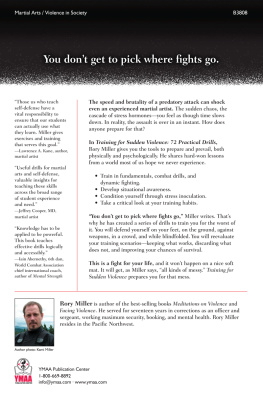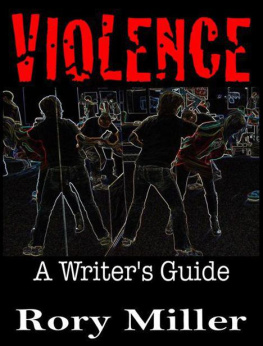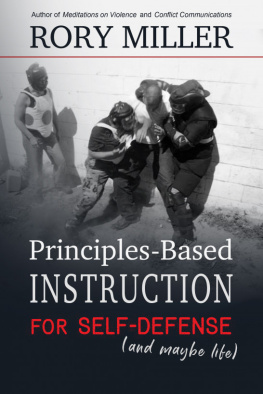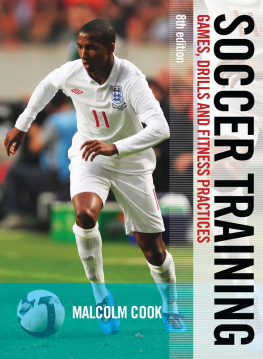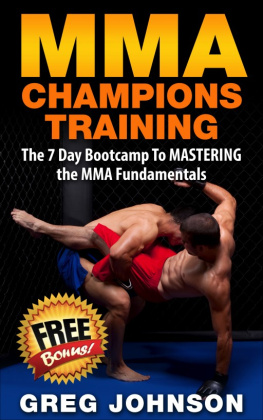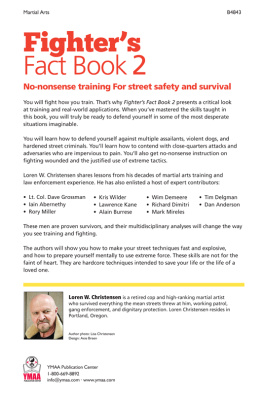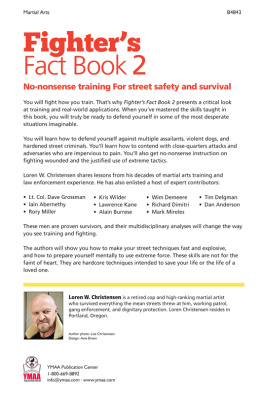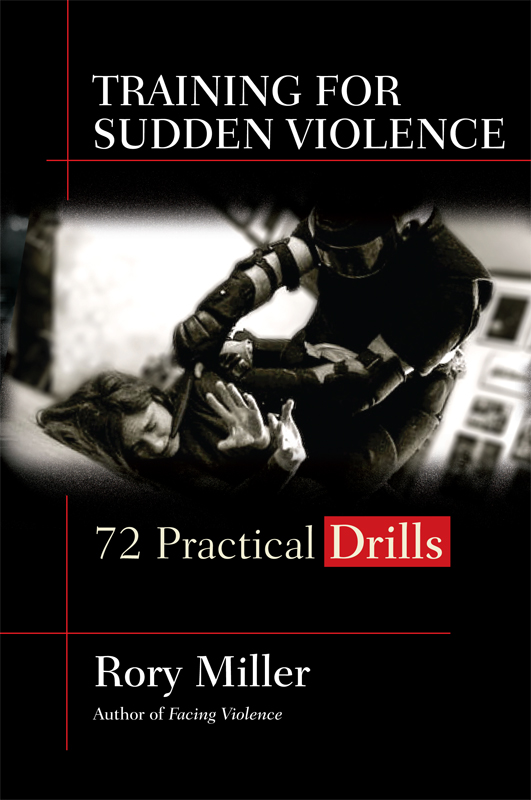Contents
Guide
Pagebreaks of the print version
TRAINING FOR SUDDEN VIOLENCE
72 Practical Drills
Rory Miller
YMAA Publication Center
Wolfeboro, NH USA
YMAA Publication Center, Inc.
Main Office:
PO Box 480
Wolfeboro, New Hampshire, 03894
1-800-669-8892
ISBN: 9781594393808 (print) ISBN: 9781594393815 (ebook)
All rights reserved including the right of reproduction in whole or in part in any form.
Copyright 2016 by Rory Miller
Edited by T. G. LaFredo
Cover design by Axie Breen
Photos courtesy of the author unless otherwise noted
Publishers Cataloging in Publication
Names: Miller, Rory, author.
Title: Training for sudden violence : 72 practical drills / Rory Miller.
Description: Wolfeboro, NH USA : YMAA Publication Center, [2016] | Includes bibliographical references and index.
Identifiers: ISBN: 978-1-59439-380-8 | 978-1-59439-381-5 (ebook) | LCCN: 2016941588
Subjects: LCSH: Self-defenseHandbooks, manuals, etc. | Self-defensePsychological aspects. | ViolencePsychological aspects. | ViolencePreventionHandbooks, manuals, etc. | Crime preventionHandbooks, manuals, etc. | Martial artsHandbooks, manuals, etc. | Martial artsPsychological aspects. | Fighting (Psychology) | Criminal psychology. | BISAC: SPORTS & RECREATION / Martial Arts & Self-Defense. | SOCIAL SCIENCE / Criminology. | SOCIAL SCIENCE / Violence in Society.
Classification: LCC: GV1111 .M557 2016 | DDC: 613.6/6dc23
The author and publisher of the material are NOT RESPONSIBLE in any manner whatsoever for any injury which may occur through reading or following the instructions in this manual.
The activities physical or otherwise, described in this manual may be too strenuous or dangerous for some people, and the reader(s) should consult a physician before engaging in them.
Warning: While self-defense is legal, fighting is illegal. If you dont know the difference, youll go to jail because you arent defending yourself. You are fightingor worse. Readers are encouraged to be aware of all appropriate local and national laws relating to self-defense, reasonable force, and the use of weaponry, and to act in accordance with all applicable laws at all times. Understand that while legal definitions and interpretations are generally uniform, there are smallbut very importantdifferences from state to state and even city to city. To stay out of jail, you need to know these differences. Neither the author nor the publisher assumes any responsibility for the use or misuse of information contained in this book.
Nothing in this document constitutes a legal opinion, nor should any of its contents be treated as such. While the author believes everything herein is accurate, any questions regarding specific self-defense situations, legal liability, and/or interpretation of federal, state, or local laws should always be addressed by an attorney at law.
When it comes to martial arts, self-defense, and related topics, no text, no matter how well written, can substitute for professional hands-on instruction. These materials should be used for academic study only.
CONTENTS
Wim Demeere
Before I talk about this book, I need to mention a couple of things.
First of all: mankind is violent. It always has been, and it probably always will be. As a species, one of the few constants in our history is the presence of violence. Be it one on one or between tribes, cities, countries, or coalitions of nations, weve been fighting among ourselves for thousands of years.
At a personal level, there are varying reasons or pretexts as to why they come to blows:
- Bashing somebodys head in to steal his money, clothes, or other valuables.
- Defending a real or perceived insult to your honor or the honor of your wife, family, or clan.
- Your emotions get the better of you in a heated argument, and you let a punch fly.
- There are many more, but for the most part, these reasons have not changed all that much throughout time. What has changed is society.
In the average Western country, violence is actually much less prevalent than it was a mere hundred or two hundred years ago in that exact same place. To put this in the proper context, ask yourself these questions:
- When was the last time bandits raided your town to loot, plunder, and rape?
- When was the last time you had to shoot or kill somebody to defend your family from being murdered by robbers?
- When was the last time you lost a family member to a lynch mob?
Once again, the list is much longer, but for most Westerners, the answer to these questions is Never. Just the questions themselves seem absurd to them, even though these things were a part of daily life not that long ago. This doesnt mean violence is nonexistent in todays societieson the contrary. It is still a part of life, but in many cases you can avoid it; in only a very few instances will an aggressor follow you all the way home if you successfully run away from him.
As a consequence, very few people have any actual experience with or accurate knowledge of dealing with violence. For the most part, they get their information on this topic from television shows and movies. Unfortunately, those are perhaps the worst possible sources you can turn to for realistic information on this subject. As a result, people no longer have the skills to cope with violence, regardless of what form it takes.
This informational void has given the opportunity to countless experts to offer their advice on this problem via books, videos, and training programs. Sometimes they offer worthwhile information; more often, the opposite is the case. But the average civilian no longer has the means to separate the good from the bad, as he lacks a realistic empirical framework to do so. This, in turn, has allowed a large number of unrealistic and inefficient teachings to flourish. Along with that, there is the omnipresence of the internet, which allows every single person with a computer to spread the most outlandish ideas on violence.
Just as the glossy magazines have indoctrinated women worldwide to strive for a size four regardless of their body type, this avalanche of faulty information on violence has become part of the collective unconscious.
One of those erroneous ideas is that training drills are useless for self-defense. Though there are indeed some popular drills that offer little of value, nothing could be further from the truth. Warriors, soldiers, and all those who routinely engage in violence have always used drills to hone their skills:
Roman soldiers started their sword training by relentlessly drilling techniques on a wooden post. They were not allowed to practice swordplay with a partner until they had mastered those drills.
Tent pegging (piercing and picking up a ground target with a sword or spear while riding in gallop) was practiced by cavalries in Asia and Europe since at least 400 BC.
- The sport of polo originated from another ancient drill for cavalries to practice sword techniques while on horseback.
- Friedrich von Steuben insisted on bayonet training drills during the American Revolutionary War, and they proved decisive on the battlefield.
If warriors from those times, when life was significantly more violent than today, understood the value of training drills, then we should probably do the same today. The only question that remains is, which drills should we use?
That is where this book comes in.

